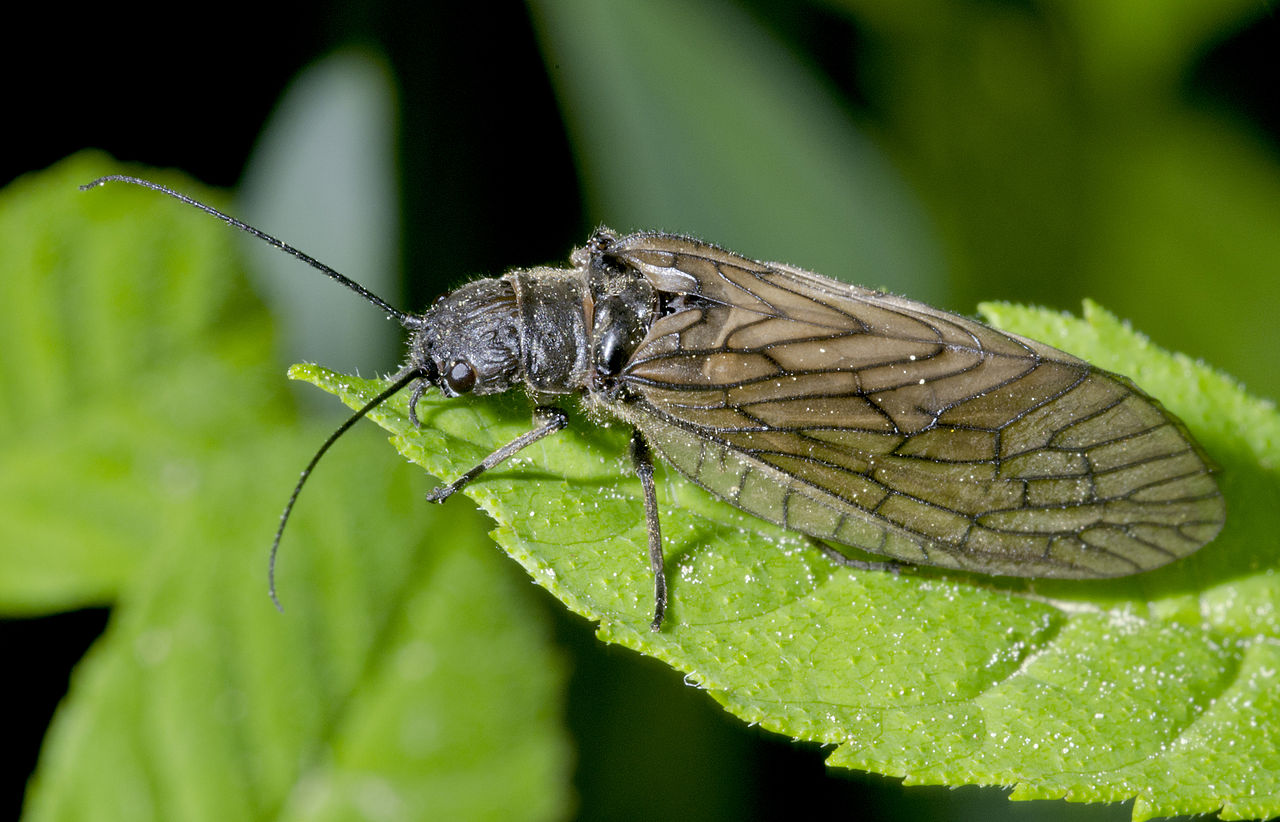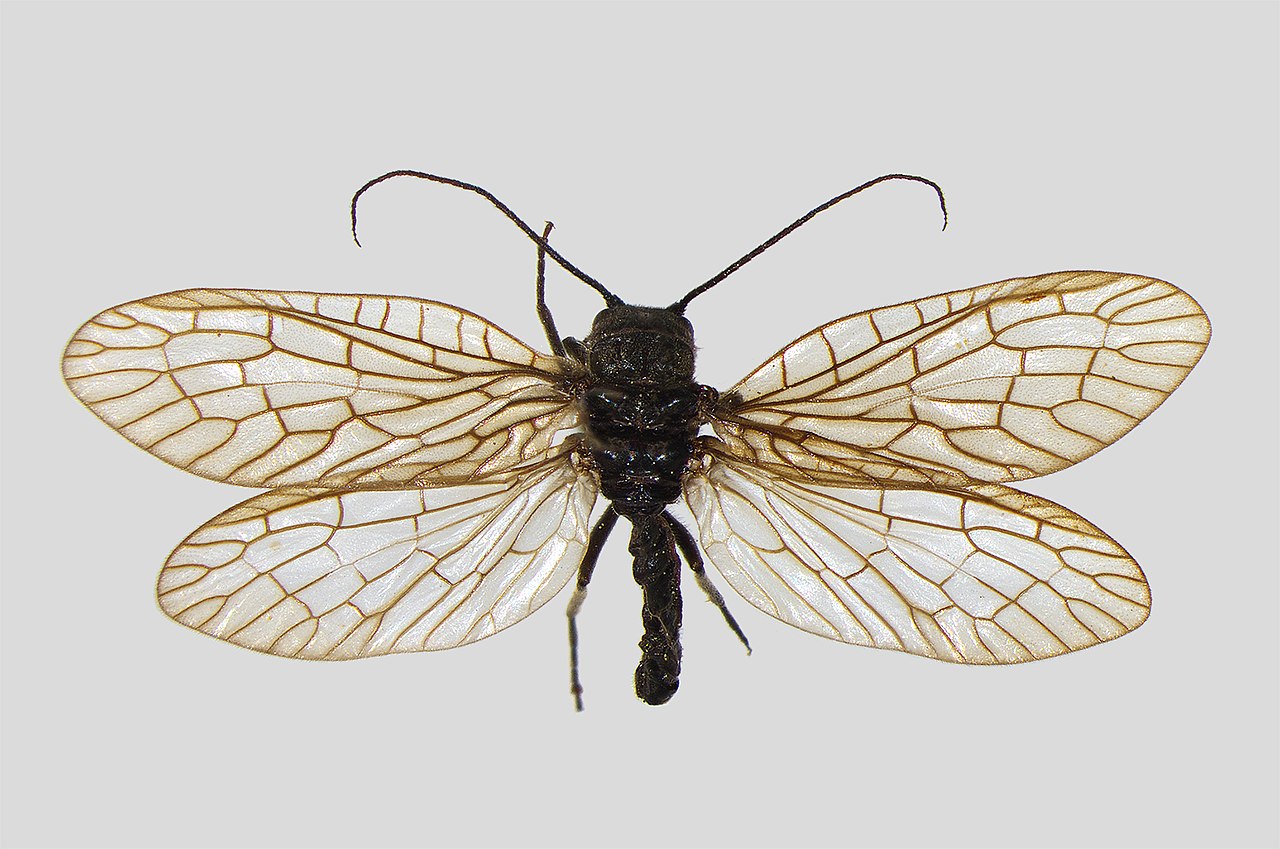- Home
- Garden Wildlife
- Insects
- Alderflies
Alderflies (often written as alder flies)
Alderflies belong to the insect order Megaloptera, which means "large wings". It is a small group with only about 300 species worldwide. They are generally black in colour with rather large brownish dark-veined wings that are held tent-like over the adult insect’s body. They are rather reminiscent of lacewings. They are 10-15mm in length and are often seen sitting on foliage near water. Alderflies have long thread-like antennae and relatively long slender legs. The aquatic larvae have large heads wih strong jaws, a pair of gills on each abdominal segment and a long tail.
Species in Britain and Ireland
There are three species of alderfly in Britain, two of which have been recorded in Ireland. By far the most common and widespread of the three Sialis species is Sialis lutaria and this is the alderfly that is most likely to be found in gardens.
Common alderfly Sialis lutaria
Biology
Adult alderflies are active in late spring-early summer. They are weak fliers and tend to frequent dense vegetation on the margins of ponds, lakes, canals and other waterways. The larvae spend the daylight hours in tunnels made in the mud at the bottom of water bodies. At night they emerge and are predators of a wide range of aquatic invertebrates.


.jpg)
Life cycle
Batches of eggs are laid above the water surface on the foliage of plants growing in or close to water. On hatching, the larvae fall or crawl down into the water. The larvae go through several stages (instars). Late instar larvae overwinter and when they have completed their development in spring, they emerge from the water and burrow into wet soil nearby. They pupate in that situation, with the adult insects emerging a few weeks later. Adults do not feed and only live a few days.
Role of alderflies in gardens
Alderflies are more likely to be found in gardens with large ponds that have well vegetated margins and their presence adds to garden biodiversity. They are often absent from small garden ponds where the margins lack tall emergent plants.
Other sources of information
Website
Website of the Lacewing and allies recording scheme
Amateur Entomologists' Society page on alderflies
Books
Elliott, J. M. (2009) Freshwater Megaloptera and Neuroptera of Britain and Ireland. Freshwater Biology Association
Plant, C. W. A key to the adults of British lacewings and allies. A Field Studies Council AIDGAP key, Preston Montford, Shrewsbury
Page text drafted by Andrew Halstead, reviewed by Andrew Salisbury, compiled by Steve Head
Larva of Sialis lutaria
Alder flies
Alder flies belong to the insect order Megaloptera, which means "large wings". It is a small group with only about 300 species worldwide. They are generally black in colour with rather large brownish dark-veined wings that are held tent-like over the adult insect’s body. They are rather reminiscent of lacewings. They are 10-15mm in length and are often seen sitting on foliage near water. Alder flies have long thread-like antennae and relatively long slender legs. The aquatic larvae have large heads wih strong jaws, a pair of gills on each abdominal segment and a long tail.
Species in Britain and Ireland
There are three species of alder fly in Britain, two of which have been recorded in Ireland. By far the most common and widespread of the three Sialis species is Sialis lutaria and this is the alderfly that is most likely to be found in gardens.
Alderflies (often written as alder flies)
Alderflies belong to the insect order Megaloptera, which means "large wings". It is a small group with only about 300 species worldwide. They are generally black in colour with rather large brownish dark-veined wings that are held tent-like over the adult insect’s body. They are rather reminiscent of lacewings. They are 10-15mm in length and are often seen sitting on foliage near water. Alderflies have long thread-like antennae and relatively long slender legs. The aquatic larvae have large heads wih strong jaws, a pair of gills on each abdominal segment and a long tail.
Species in Britain and Ireland
There are three species of alderfly in Britain, two of which have been recorded in Ireland. By far the most common and widespread of the three Sialis species is Sialis lutaria and this is the alderfly that is most likely to be found in gardens.



Common alderfly Sialis lutaria
Biology
Adult alderflies are active in late spring-early summer. They are weak fliers and tend to frequent dense vegetation on the margins of ponds, lakes, canals and other waterways. The larvae spend the daylight hours in tunnels made in the mud at the bottom of water bodies. At night they emerge and are predators of a wide range of aquatic invertebrates.
.jpg)
Larva of Sialis lutaria
Life cycle
Batches of eggs are laid above the water surface on the foliage of plants growing in or close to water. On hatching, the larvae fall or crawl down into the water. The larvae go through several stages (instars). Late instar larvae overwinter and when they have completed their development in spring, they emerge from the water and burrow into wet soil nearby. They pupate in that situation, with the adult insects emerging a few weeks later. Adults do not feed and only live a few days.
Role of alderflies in gardens
Alderflies are more likely to be found in gardens with large ponds that have well vegetated margins and their presence adds to garden biodiversity. They are often absent from small garden ponds where the margins lack tall emergent plants.
Other sources of information
Website
Website of the Lacewing and allies recording scheme
Books
Elliott, J. M. (2009) Freshwater Megaloptera and Neuroptera of Britain and Ireland. Freshwater Biology Association
Plant, C. W. A key to the adults of British lacewings and allies. A Field Studies Council AIDGAP key, Preston Montford, Shrewsbury
Page text drafted by Andrew Halstead, reviewed by Andrew Salisbury, compiled by Steve Head












